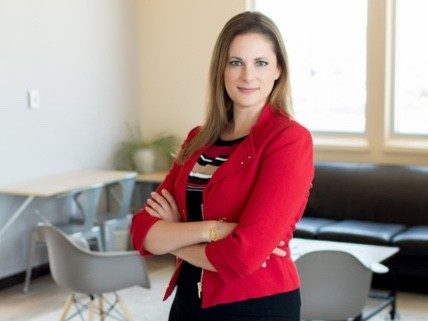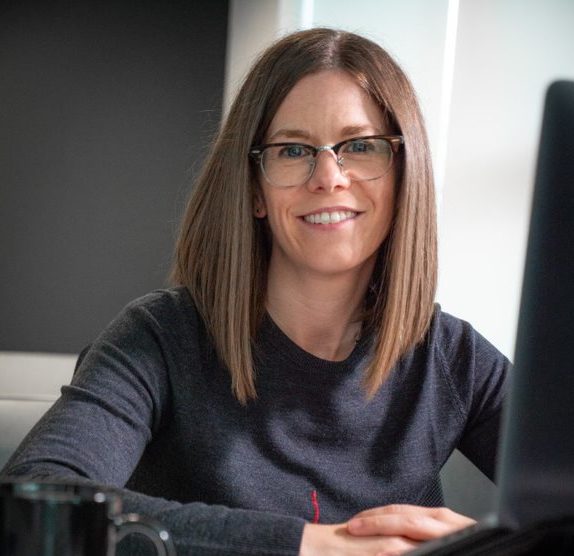Those who have been in this world for a while are probably a little confused. Wait, are you talking about an intranet or a digital workplace? Are they the same thing? Do I still need an intranet, or do I put that in the corner with the fax machine?
Elena Bogdanova helps Russian companies develop intranets that actually work. This of course, means lots of updates and a constant rethinking of the purpose of digital sharing.
When trying to compare intranets and digital workplaces, Elena gave this beautiful quote:
“So, if I would explain it to my mom, I would say, look, intranet is one app that you have on your mobile and digital workplace, it’s all apps that you have on your mobile. If I would explain to my client, I would say, intranet, it’s one system that you provide to your employees that they can do their job. And digital workplace, it’s all systems your employees have to do their jobs. And then I would probably say what systems they have like intranet including, messengers, emails, ERP systems, LMS systems, everything that they have in the digital world that they provide for employees. And probably if I would explain it to the experts, I would say, see, intranet is the old term of the digital workplace. If you want to be cool, you say the digital workplace.”
Digital workplaces in Russia
Elena says that Russian workers have a very high expectation for the user experience of any app that a company offers. Most enterprise companies opt to develop something on their own rather than use off the shelf tools.
One interesting trend is that many Russian companies are tracking metrics to make sure their employees don’t burn out. Along with some of the common health screeners, they are asking some non-invasive questions to see how their lives are going and be better equipped to provide help.
Digital communities
Elena is also a very active community organizer. She runs a lot of events for people in her space. After COVID, everything went digital. But she also found that people were much more likely to come to these events after they RSVP’d. For live events, something would come up and they’d have to cancel. But especially in the heart of the pandemic, EVERYONE who signed up for an event showed up.
Tips for building your own intranet
When thinking about the core of your digital workplace, Elena gave these tips.
- Don’t try to building something yourself. It gets really expensive quickly. Better to go with an out-of-the-box solution.
- Elevate your messaging platform. If you are using SMS, Whatsapp, Viber, or any other consumer app service, you really need to find something professional that can help your communication.
- Get in the habit of saving things in common folders as soon as possible. It’s an impossible problem to solve in enterprises, and smaller companies need to build these skills and culture quickly.
Links
Welcome back to The Digital Workplace podcast. Today, our guest is Elena Bogdanova. She is the CEO of Rivelty Intranet. Hi, Elena. How are you today?
Hi Neil, I’m doing well.
Yeah, it’s great to talk to you. You’re coming to us from Moscow, so welcome to you. I think you’re our first guest from this side of the world.
Oh, really? Well, thank you.
Good. Well, one thing we do at the start of all of our shows is, what we call our capture question just to prove that you’re a human. So, I didn’t really prepare you for this one. So, here’s your question, tell us a non-family member that really impacted you as a child. Tough one.
Wow. Hard to answer. Umm, non-family. Well, I guess my cat can be a non-family member.
Yeah sure. That’s a very human answer.
Yeah. Okay. Yeah. Then my cat. Siamese cat. I had a Siamese cat.
Oh, as a child, you had one growing up, huh?
Yeah.
And it was very much a part of your family almost? Like it was touching to you.
Yeah, she was really touching, to me. But then, there was a bad story that happened while I wasn’t there. And my parents didn’t tell me that for a long time. Yeah, it was a really bad story. But yeah, she was really attached to me.
Yeah. Hmm, what was her name?
Her name was Kryska.
Nice. Okay, we should start all podcasts talking about cats. I think that’s a good way to show that we’re real humans.
Yeah. In Russia, Kryska means rat. I don’t know who named her Kryska but it just happened.
Nice. Excellent. Well, good. Tell us a little bit about your company, about Rivelty. What do you do and what types of work are you involved in?
We help companies to build intranet that work. So, we do the consultancy. We help to build their intranet concept that will really work, that will help employees to do their job better, to be more efficient, to be more happy, and that helps companies to save money on time that employees save using this intranet.
Excellent. How long have you been in that business?
So, I own the company for five years almost. And I’ve been in intranet for already 12 years or so.
Yeah. So, let’s just start with that term, intranet. And you know, the show’s called The Digital Workplace. So, when you hear those two terms together, this, now that we’re here in 2021, what do you think is the difference between those two?
It’s a good question. So, if I would explain it to my mom, I would say, look, intranet is one app that you have on your mobile and digital workplace, it’s all apps that you have on your mobile. If I would explain to my client, I would say, intranet, it’s one system that you provide to your employees that they can do their job. And digital workplace, it’s all systems your employees have to do their jobs. And then I would probably say what systems they have like intranet including, messengers, emails, ERP systems, LMS systems, everything that they have in the digital world that they provide for employees. And probably if I would explain it to the experts, I would say, see, intranet is the old term of the digital workplace. If you want to be cool, you say the digital workplace.
There we go. That’s the real insider definition. Good. So, when you’re working with a client, how often do you feel as they’re describing their issues and the solution that they want the intranet to do, do you really think, wait, this is a bigger thing than just an intranet. You need to zoom out. Do you find yourself really consulting on a big, large scale? Or is it usually people know exactly what they want when they come to you?
Oh, well, usually we do the intranet relaunch. So, most of our projects, it’s about, well, it’s enterprise segment. It’s the biggest Russian companies. So usually, they already have something and it’s not working, or it’s really outdated already. So, they want to make it brand new. They want to reload it, but on a much better level than they have now. So, it’s more like relaunching and we help them with a concept. We help them to understand what to leave, what to rebuild, what they should get out of. So, it’s more like helping to, I would say, I would talk about an apartment. I would say, to help them to make a new design, but not only in design that works, but that is really user friendly, that really helps them live in this apartment.
Yeah. I feel like if your job is to fix other people’s intranets and old ones, then you’ll have work forever.
Yeah. Because I think that an average life cycle of intranet, it’s three to five years. So, the companies that we build the intranets in when we started, are already coming back, because they’ll do the new one. So yeah, I hope so.
Well, excellent. I feel like that’s so key to understand that it’s never done. It’s always something you have to be improving. And whether we’re talking about intranets or digital workplaces, it’s always going to be something that you must have to have someone constantly looking at how to improve it, just like any corporate website itself. It’s always in a state of flux and always looking to improve as well, too.
Yeah. That’s true. Exactly.
Yeah. All right. Well, tell us about what’s going on in Russia. I know that that’s your home. You do work outside of that and work with other companies as well. But what’s the state of digital workplaces in Russia? What’s some cool stuff going on that the rest of us should know about?
Good question too. The main thing that makes us different, compared to, I would say European intranets and maybe a bit, intranets in the States and Australia, is that here we invest a lot in UX inversion. Everybody’s really spoiled with good UX in day-to-day life. So, all apps that they have in mobile are fairly easy to use. So, employees, of course, and users are expecting quite a good UX inside the company for the tools that they are used to. So, we invest a lot in UX. What else? Here also, the situation is that around 30% of the company’s preferred way is, of self-developed platforms. We have a lot of digital workplaces built in-house. I would say that we have a lot of smart IT people and they’re not so expensive. And we love everything custom, that is built in particular to our needs.
So, many companies choose the way of self-developed platforms.
And I think it’s also quite different compared to the rest of the world. And even if we choose like SharePoint or something, like out of the box solution, it’s still rebuilt quite a lot. So, sometimes it’s really hard to say, ‘Oh, is it SharePoint? I would never say that it’s SharePoint because it’s so much different.’ And if to say something about the trends that we see from last year, the new things that are really getting popular, it’s a tool that helps to measure the level of employees burning out during the pandemic. I think it’s something new that we see on the market and it’s getting popular.
Yeah, let’s get into that a little bit more. What type of metrics are they using to measure burnout?
Oh, I would say it’s around 25 different criteria. So, they do polls, surveys. Every day, they ask five questions, like how do you feel? Are you overloaded with your job? Are you overloaded with your kids? So, something like that. And they’re in a random manner, like I would say using artificial intelligence. So, they’re collecting data, trying to collect a lot. And they also collect how you work on your computer during the day, the messengers, connections, and how much you work on the computer. So, all this information.
Yeah. I can almost imagine like one signal is how hard you’re pounding on your keys.
Yeah probably.
That should do it.
And how loud is your background, the kid screaming, or the dog. So, they collect all the data and then they do their statistics or reports on the employees that can burn out.
That’s really great to know that that’s something that people are caring about and wanting to know, especially in the last year. That’s great things to know. I feel like we’re at a place where we recognize that technology is available for us, we can gather in all these things. I’m almost thinking about the check-ins that we’re having to do just with our health, you know, do you have a fever? Do you have a cough? Like those types of things. I think we’ll see a merging of those two things and just overall wellness get these daily checks.
Yeah, this is actually what we had during the pandemic. Because every Russian company is supposed to provide to the government information about their employees, who is sick, or who could be with COVID-19 virus inside. So, some companies on the intranet did a small tool where every three or four hours you have to add your temperature, how you feel, if you need a doctor, or if you need to connect with the insurance company. So, every four hours, they collect this data to get the information and to control how is the employee who stays at home. We had this.
Yeah, I can imagine. Even when in office settings, those kind of constant temperature checks are going on and people are checking those things. And that’s going to be part of our future, I imagine.
Yeah.
So, we have the data, we have things. So, once a leader or a manager gets that data and says, ‘Yes, you know, Elena is stressed out. She’s on the verge of burnout.’ What are the typical ways that a manager is going to respond to that? Is it just like, ‘Oh, that’s too bad’, or what are the levers they’re trying to pull to fix that?
Well, I think it could be different in different companies. But I would say probably the most typical way is that we’ll try to talk with employee and ask, what could be the reasons of this, if he needs some time to rest, if he needs some professional assistance. Many companies started to pay for the psychology therapists for the employees, and they see it’s become really popular. Even in our company we decided to do so. So, if they need assistance, they would probably cover it, or give the chance to rest or something like this. If they are overloaded by the projects or tasks, they probably try to move something. Of course, it’s not for everybody. It’s more related to, I would say, most important employees, the ones who are high-po employees, not for everyone. I know one of the projects that did really well in this program of measuring the burning out level. So, it was for mostly 30% of the employees. So, mostly for high-po or high potential employees.
Yeah. Wow. That’s interesting. Well, let’s switch a little bit because you also do another role in your life, which is basically like a community organizer. You try to get a lot of people excited about intranets. You host a lot of things which, for any community organizer like last year, was like, ‘Oh my gosh. What do I do?’ So, tell us about your journey. Tell us about the communities you manage and that you organize and what’s the last year been like for you?
So, we have an intranet community I would say. It’s around 400 people now. It’s in online format. We have a closed group on Facebook. And before, once in a month, we met offline with some members who live in Moscow. And I would say, for us, pandemic was a good thing. Because before, like, for example, 30% would sign up to show up on offline meeting and 20 will appear. When we switched to online format, 50 people would register and 49 will come. Because, like before, we had a meeting during the evening in an offline format. So, after work, you have to go somewhere. And it’s time, traffic, rain, cold, snow or something. So, not many people would appear.
But when we switched to online and moved our meeting during the lunchtime, we get almost 100% people who sign-up, they show-up. So, I would say for us, it was a good thing to move online. And I think I would say about the members, what we noticed was that the people became more closer. Earlier, in our meetings, it was more about talking how good we are. And look we did this, we did that, and we are so good and everything. But now it’s more about sharing how hard it is and finding the people who are in the same situation, to find support, to realize that you’re not alone. So, I think during the pandemic, the community became more close, and more people oriented than result oriented.
Yeah, that’s really fascinating to think about that kind of closeness that’s coming there. Do you feel like that’s more related to just the pandemic in general, that everyone is going through a hard time or is there a digital nature that changes that? Do you feel like when you get back in person, you’ll be able to maintain that closeness and that vulnerability?
Hard to say at the moment. But I think, well, I believe that this time is not going to go fast. So yes, we’ll live in this for some time. So probably, we will even see if we move offline again. But now it won’t be offline only. It will be either hybrid or still more online. Like for our community, it’s mostly more online. But yes, we do, we will do the offline events too, to get the feeling that we are live people too.
Yeah. And I think that’s a great balance to think about that. Probably the core of what you’re doing, what other people are going to be doing, will be these kinds of regular digital events that are a pain to drive to and back and forth and you can get to easily. But then maybe having once a quarter or something like a bigger event where there can be some generating buzz and excitement and getting together. And so, I think that finding that blend will be important. Sure.
Yeah, just agree. Yeah.
Excellent. Well, good. Well, our core audience tends to be digital leaders, CEOs of companies from 25 to 250 employees. So, they’re in a place of building what they want. So, I know you work mostly in the enterprise segment. So, what can you tell somebody who’s building where they are now, they’re thinking about, yeah, I want to use some tool to make sure that we’re in a good place as we get better and as we get bigger, excuse me, not necessarily better. What is something that they need to be preparing for at those stages that can give them just a good footing, good hygiene, good preparation, so that they’re going to have a long, successful digital career?
Neil, can you ask this question again? So, can you say it again?
Yeah, it was a really long question. I do this sometimes. So, imagine you’re talking to somebody who’s leading a company that’s a little bit smaller. What are the digital habits they need to have in place now, so that as they grow, they can continue to get a lot of good returns out of a digital workplace or an intranet that they want to have?
Another good question, I think.
The second one was a good question. The first one was rambling.
I think we are the ones who are in this situation now because we are a company who are around 25 people and we’re growing, and I would say the rules that work in the enterprise segment are not working. We tried many. And it’s like, in Russia, we say, I’m the shoemaker without the shoes. So, this is what we have at the moment. And we are trying to build the processes so that everything works, and in the future when we are growing, it will be still stable. So, what I would probably recommend, not try to build or to buy or to find a system that will cover all your needs. It’s impossible. Especially if you’re a small company, don’t go to customization or don’t invest into self-developed things. For example, we did it. We invested a lot of money on self-developed things. And the more we have it, the more expensive it gets. So, now we are moving to an out of the box solution that is supported by the third parties and it’s growing, building, and UX improving, etc.
So, don’t go to the self-developed things. Try to find tools that will cover the particular routine work types. Don’t forget about the messenger. Try to escape using WhatsApp, Viber, or Telegram which is popular here. So, probably go to Slack or Teams, or something more corporate type of instrument. Teach employees the importance of saving the knowledge and saving the documents in particular folders or particular community spaces on, for example, your Office365. Try to build a habit that it’s not only for you, and not only for now. It could be useful sometime later. So, I noticed that in smaller companies, employees do not have these habits, and the CEO, they don’t have time to think about knowledge saving and everything. And this is what you need to learn, that you need to move to the habit. So, probably this one, too.
Yeah, that’s great. We talk a lot about the durability of communication, like how long do you need it to live? If it’s just chat type stuff that’s going on in Slack, that’s fine. But once you say something really important in Slack, you need to pull it out of there and put it somewhere else so that you can refer back to it later. If you have really important documents and decisions you’ve made in Microsoft Teams, good luck. Because it may be months before you realize you need it again and you don’t know where it was and it’s hard to find. So yeah, great advice. Great. Well, Elena, it’s been really fun to talk to you. It’s great to get your perspective on everything. I’ve enjoyed this a lot. If people want to know more about you and the work you’re doing where should they go?
They can go to our website. It’s rivelty.com. We have English version. Of course, the Russian version is much bigger, but we have a small English one. And of course, my LinkedIn or Twitter. You can find me there.
Yeah, great. We’ll put all that in the show notes. Elena thanks for being on the show. We look forward to talking with you again soon.
Thank you so much. Thank you. I really enjoyed it too. Thanks Neil.
Elena has been in the intranet space for more than 10 years. Starting as an internal developer, she took on the challenges of being an intranet project manager and leader, before ending up as an intranet consultant.
Elena’s experience in leading intranet projects, and networking globally lead me to start her own company Rivelty.Intranet in 2016. The team helps to develop intranets and digital workplaces in Russian companies. They worked with different size companies (300 to 250 000 employees): VTB bank, EVRAZ, Sberbank, Gazprom Neft, Nornickel, AstraZeneca, X5 Retail Group, M.Video-Eldorado, and others.
Being passionate about intranets Elena has been tirelessly fostering and leading the Russian Intranet Community (350+ people), actively participating as a conference organizer, inviting international experts, blogging, and translating world practices.
She spoke at international conferences: DWG24 Live 2019-2020, Digital Employee Experience in Sydney, 2018, IntraTeam Event in Copenhagen and Stockholm, 2018-2019, Intra.Net Reloaded in Berlin, 2018.
Inspired by the best international events in the Intranet industry and confident that the members of the Russian intranet community have a lot to share, Elena and her team at Rivelty.Intranet organized #RiveltyConf – communications with passion conference and Russian Intranet awards #RIawards – the first intranet contest in Russia with an international jury of well-known intranet experts. They created it to develop the local intranet industry, as well as to encourage and motivate strong intranet leaders and teams in Russia.












